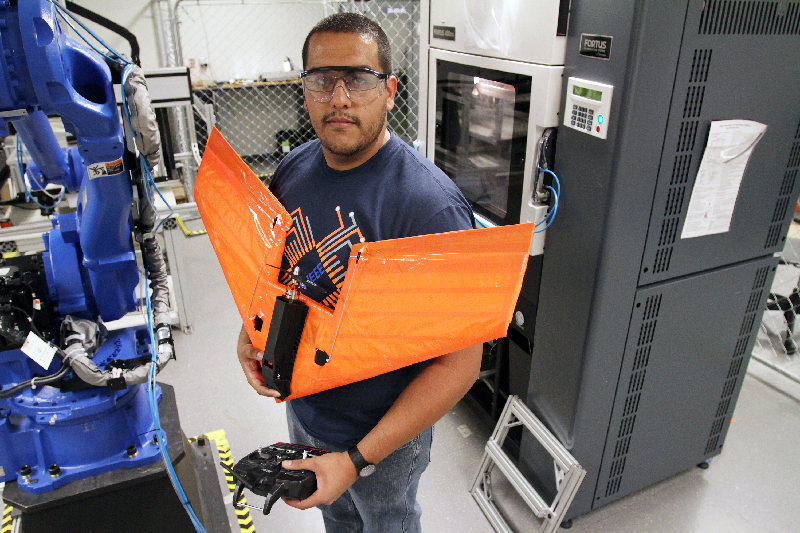Originally published May 29, 2015
By Nadia M. Whitehead
UTEP News Service
Handmade drones are a thing of the past. The new dream is push-button technology that will print a working unmanned aerial vehicle, or UAV, right before your eyes.
But getting there has been challenging.
While it may be easy to print a UAV’s plastic or metal frame, the embedded electronics and motor that bring the vehicle to life are the hard part.

“Researchers around the world have struggled to create 3-D printed electronics in the last decade,” said Eric MacDonald, Ph.D., an electrical and computer engineer at The University of Texas at El Paso. “But we here at UTEP have made tremendous gains and have invented several advanced 3-D printing technologies enabling 3-D electronics.”
Co-director of UTEP’s world-renowned W.M. Keck Center for 3-D Innovation, MacDonald has spearheaded a number of 3-D printing projects. More recently, MacDonald and the lab have taken on UAVs with 3-D printed electronics.
The first prototype – a small, black and orange aircraft with a two-and-a-half-foot wingspan – is promising. Although it has yet to be perfected, its incorporation of multiple materials (plastics and circuitry) using an all-in-one 3-D printing process puts it ahead of the game.
“The thing that UTEP is famous for is its ability to print multifunctional, multimaterial structures,” said Thomas Hiromoto, a mechanical engineer at Lockheed Martin who has seen the UAV. “Creating the mechanics and electronics of a structure in one manual process limits the amount of labor involved and lowers the part count.”
As the project sponsor, Lockheed Martin has a vested interest in the development of 3-D printed UAVs and 3-D printing in general.
“Additive manufacturing, or 3-D printing, allows flexibility and lets us react quicker to new needs,” Hiromoto explained.
For instance, if the Department of Defense needed a drone quickly, what normally would take weeks to manufacture and deliver to a remote location could be done on the spot in a matter of hours. At the same time, 3-D printing allows for faster design changes.
“Someone can quickly redesign a UAV to fit a specific mission,” said Efrain Aguilera, the undergraduate engineer who was in charge of getting the drone project on its feet. “If you need a drone that can fly long distances, you can increase the wing size, or if you need something stealthy, you can make the drone smaller.”
All these redesigns take place on a computer-aided design (CAD) system that engineers are trained to use, Aguilera explained. Once complete, the design is passed through software that slices the 3-D design into layers, making it readable to 3-D printers.
In the case of UTEP’s UAV, Aguilera designed the body of the aircraft entirely on his own.
As the plastic black frame began being printed layer by layer, Aguilera would pause the machine to embed the electronics by hand. In the future, a high-tech robotic arm will replace Aguilera. The machine will place the copper wires onto the frame and then continue incorporating the circuitry into the printed layers.
“While I may be using my hands now, eventually everything will be printed at the push of a button and come out fully functional,” said Aguilera, who earned a bachelor’s degree in electrical and computer engineering in May 2015.
But UTEP’s 3-D printing technology goes further than UAVs. The University holds several patents on 3-D printing processes capable of embedding electronics into a final product.
These patents alone are a starting point for the push-button, 3-D printing dream, so the technology’s applicability is endless.
In the meantime, Aguilera will continue perfecting his UAV and preparing it for flight when he returns to UTEP in the fall for graduate school.